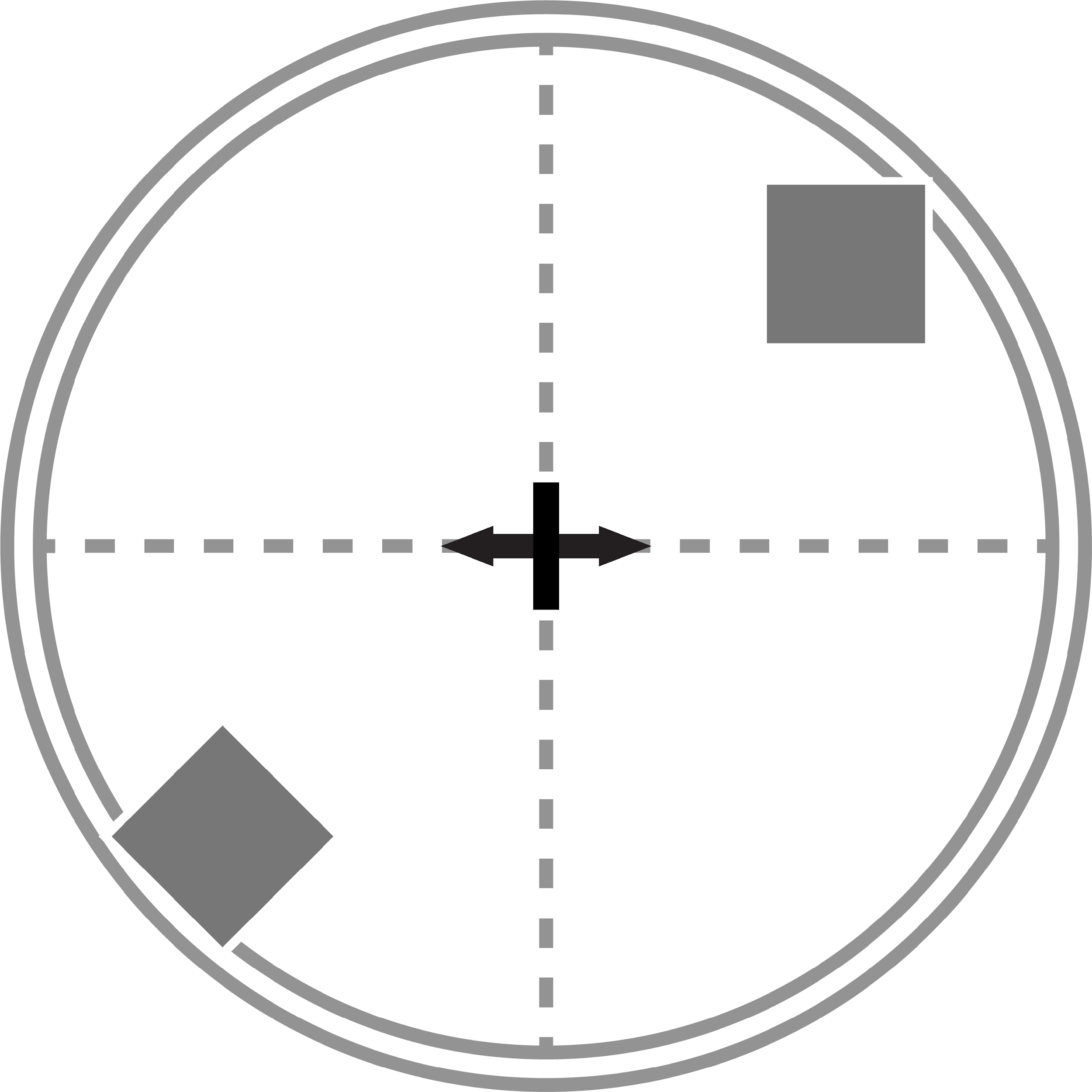Similar to Mega Sumo, Mini Sumo robots must be within the 0.5kg weight limit and in the size limit of 100 x 100mm. The battle ring has a diameter or 800mm made of non magnetic material. The robot must be fully autonomous and be able to start and stop on command from the referee via star/stop module (see appendix in the regulations).
1.General information
The matches will take place between two teams, each team having one or more members. During the battles only one member may approach the ring, the other team must watch the match from the public. According to the rules, the teams will compete in a Dohyo (sumo ring) with an autonomous robot, own creation as specified in Section 3 and 4.
The referee designate the start of the match with the remote control, and it continues until one of the two robots get 2 points "Yuhkoh". The referee designates the winner.
2. Team
2.1. A “team” is composed from one to five students who have built a robot for this event.
2.2. The robot must be an autonomous robot constructed by themselves prior to the competition to the specifications below. This robot category is not a workshop where you may build robots after arrival. There will be limited time for adjustments and changes to the robots and their programming during the event.
2.3. Each team / robot will receive a check-in number and should have a unique name or identity to be easily recognizable by spectators and officials when they are on the field and when they score.
2.4. Each team/robot will be assigned a number on check-in and should have a unique name or identity to be easily recognized by spectators and officials when on the field and when scoring.
2.5. Matches will take place between two teams that have built a robot for this category. During the battles, only one member can approach the ring, the other team members must follow the match from the public.
3. Robot Construction
3.1. There will be limited time and space for last minute design improvements and adjustments, however, the robots should be completed at the time of registration, and once check-in takes place, the robot or its programming may no longer be modified. Robot battery should also be sufficiently charged once the robot is checked in.
3.2. Any type of electronics are permitted, there is no limitation to module brand or home made components as long as they conform to safety standards.
3.3. All robots must be autonomous. Any control system can be implemented, while it is inside the robot and does not interact with external control systems (human, machine or another).
3.4. For safety reasons the robots must be equipped with a sensor on/off (infrared) which will be operated by the referee. When the referee sends a stop signal, the supply of the engines has to be cut. The sensor will be used also to simultaneously activate both robots, by the referee. The specifications for the sensor on/off IR are in Appendix 1.
4. Robot limitations
4.1. When started on the Dohyo, the robot can’t be more than 10.3x10.3 cm.
4.2. Height is not restricted.
4.3. The maximum mass of the robot shall not exceed 0,505 kg.
4.4. When the referee sends a start/stop signal, the robot must act accordingly.
4.5. The startup robot may expand. It is not allowed to separate the robot into 2 or more pieces. The robot must remain a single centralized robot. Components with a mass of less than 5 grams will not result in loss of the match.
4.6. It is forbidden to use devices that can store liquid, dust, gas or other substances to be thrown to the opponent.
4.7. Devices that throw objects to the opponent are not allowed.
4.8. Sticky substances to improve traction are not allowed. Wheels and other components of the robot that are in contact with the ring should not be able to lift and hold a standard A4 (80mg / m²) sheet for more than 2 seconds. Robots will be screened at the approval stage and may be rechecked at the referee's request at any time during the competition.
4.9. Surface pressure-enhancing devices such as vacuum pumps or magnets / electromagnets are NOT allowed.
4.10. All robots must be autonomous. The autonomous robot movements will have to detect and / or react / attack the movements of the adverse robot. If there are doubts as to the robot's autonomy, the referee has the right to inspect the logical control of the robot.
4.11. It is forbidden to use devices for jamming opponents, such as radiation sources to saturate sensors, ultrasound transmitters, or other devices with similar effect, are strictly forbidden.
4.12. There are not allowed components of the robot that can destroy the playing area. Do not use components intended to destroy the robot of the opponent. The thrusts and the normal blows specific for a sumo match, are not considered intentions for destruction.
4.13. Any devices that throw flames are not allowed.
4.14. Any devices that throw objects towards the opponent are not allowed.
4.15. The blade of the robot and the expansion cannot be white.
4.16. Robots who will not follow these rules will be disqualified.
5. Programming
5.1. The robot must be autonomous. No Bluetooth or other wireless control of the robot on the field is permitted.
5.2 All robots must be autonomous. The autonomous robot movements will have to detect and / or react / attack the movements of the adverse robot. If there are doubts as to the robot's autonomy, the referee has the right to inspect the logical control of the robot.
6. Technical inspection
This step will take place before the beginning of the competition. Each team will have to pass the technical inspection stage in order to be able to participate with the robot in the competition. After approval, all teams will necessarily remain in the competition room.
The stages of the technical approval process are:
6.1. Verify the size of the robot by placing a 15.3 x 15.3 cm box/frame over the robot.
6.2. Weigh the robot on a digital scale. The maximum value of the scales shall be 1.505 kg.
6.3. The wheels of the robot and other parts that are in contact with the sumo ring must NOT be able to pick up and hold a standard paper A4 (80g/cm2) for more than 2 seconds.
6.4. Check the operation of the IR sensor both when starting and stopping the robot.
6.5. The robot will no longer be retained after approval.
7. Dohyo (ring of sumo)
7.1. The inside of the ring is defined as the surrounding black area, but also includes the white line. Any surface outside the ring will be called the outside of the ring.
7.2. The playing surface is defined as a 3 mm thick black disc with a diameter of 77 cm.
7.3. A white band is on the outside of the black area and has a width of 2.5 cm.
7.4. A 3.5% tolerance is allowed in the construction of the contest surface.
7.5. There is a safe space outside the ring. This space can be any color, it can be of any material and can have any shape. This area with the ring at its center will be called the ring area.
8. Conduct of the contest
8.1. Robots will be divided into groups according to the number of participants. The competition will take place in the group / quarter / semifinal / final system to allow as many rounds of play as possible for each robot.
8.2. Each match takes place in the best of 3 rounds and will be supervised by 2 referees (1 main referee and 1 assistant), except for the finals where the match is played in the best of 5 rounds. The decisions of the referees must be unanimous and are final, and their challenge leads to disqualification from the match.
8.3. During the contest a team is entitled to 2 interruptions for reprogramming during matches, 5 minutes each (2 interruptions in the contest).
8.4. Other breaks are only allowed for mechanical problems and only with the referee's agreement of maximum 5 minutes each. This rule is applied only when a match is taking place. Besides matches, changes and reprogramming are allowed. Teams are required to appear at the start within 1 minute of receipt of the request, otherwise they will lose the match.
8.5. After approval all teams remain in the competition room. Teams can only leave the room for repairs. If a team leaves the competition room, it must return within the specified time by the referee. If the robot does not appear on the first call, it loses the match.
8.6. If two robots of the same team advance to quarters/semifinals/finals and play one against the other, they must play the match, without demanding that one of them advance without play, or to demand to arrange the matches or the opponents.
9. Playing the match
9.1. Robot start position. At the instructions of the referees, the two teams approach the ring to place the robots on the contest surface. A cross with two opposite arrows placed in the middle divides the sumo ring into four quadrants. Robots must always be placed in two opposite dials according to Figure 1. After the robots have been positioned, the cross is removed, the moment the robots can not be moved.

Figure 1. Placing the robots on the battle ring.
9.2. The Start, Stop, Interruption or Continuation of the match is announced by the referee.
9.3. A match will be played for a maximum of 3 minutes. It will begin and end at the referee's command.
9.4. The start is given by the referee in each round by means of a remote that sends a signal to the robots, who in turn will leave immediately without delay.
9.5. End of the match. When the referee announces the end of the match, the two teams are allowed to lift the robots from the ring.
9.6. A match consists of 3 rounds, each of which lasts for a maximum of 3 minutes, with the possibility of time extension by the referees.
9.7. Extension: an additional match, if requested by the referee, will take up to 3 minutes.
9.8. A team receives a "Yuhkoh" point when they win a round.
9.9. The first team that wins two rounds or receives the first two points "Yuhkoh" until the end of the time limit will win the match.
9.10. If the time limit is reached before a team receives two "Yuhkoh" points the team with the most points will win the match. (for example 1-0 points out of 3 matches).
9.11. If a match is not won by any team during the limit, an additional round will be played. After all options have been exhausted, the winner of the match may be decided by referees by drawing lots or other criteria set by the arbitration panel.
9.12. If one of the two robots does not start, a restart will occur. If the rest of the robot does not leave, the match will be won by the moving robot.
10. The score
10.1. One "Yuhkoh" point will be awarded when:
A. The robot of a team forces the opponent to come out of the ring by pushing or lifting maneuvers. The adverse robot is considered defeated if it touches with any part or component the outer surface on which the ring is placed.
B. The adverse robot comes out of the ring for whatever reason.
C. The adverse robot fails without continuing the round and the team's representative announces this.
10.2. When determining the winner falls to the arbitrators, after exhausting the Mini Sumo competition criteria, the following considerations are considered:
A. Quality of robot construction and programming.
B. Penalty points accumulated during the match.
C. Team attitude during the match.
10.3. The match is stopped and the round is redone when:
A. Robots spin around each other without visible progress for 10 seconds. Robots are blocked for more than 3 seconds. If it is not clear that the robot is making progress, the observation time can be extended up to 30 seconds.
B. Both robots move without making any progress, stop (at the same time), or stop for 10 seconds without touching. However, if a robot stops moving, after 10 seconds, it will be declared without a fight initiative. In this case the opponent will receive a "Yuhkoh" point.
C. If both robots touch at the same time the outer surface on which the ring is placed and it can not be determined which robot has touched the first exterior, the round will be replayed.
11. Repairs, modifications, unexpected interrupts
11.1. If a robot fails during a match, the Referee will allocate a 1-minute repair interval. This interval can be extended up to 5 minutes with the organizers' agreement. Repairs will be supervised by an assistant referee to avoid changing the robot modules with other non-approved ones.
11.2. If a robot can not be repaired within the specified interval, the match is won by the opposing robot and the defective robot team can continue the repairs until the next match in which they participate and in that case being supervised by a referee / member of the organizing committee.
11.3. Replacement of defective parts can be performed and batteries can be charged during the competition, if necessary.
11.4. A competitor may ask to stop the match when he / she is injured or the robot has suffered damage and the game can not continue.
11.5. Failure to continue a match. When the game can no longer continue due to injury of the competitor or damage to the robot, the competitor who caused the injury or robot's damage or failure will lose the match. The only robot to robot damage is permitted during official matches. If one can not decide who is to blame, the one who will ask for the match to be stopped will be declared defeated.
12. Player Restrictions
12.1. When teams are called to the dohyo for their robot, teams present to the field promptly, and each team has to greet the other with a bow or handshake.
12.2. Players have to behave in a respectful manner, and are not permitted to use profanity or insulting words or actions, or to have their robot use such words or actions. Unsportsmanlike behavior will not be tolerated. Such behavior will result in a violation or disqualification at the judge’s discretion.
12.3. Only one team member may enter the match area to place and take the robot of the dohyo.
13. Judging
13.1. No objections shall be declared against the referees / judges' decisions.
13.2. The lead person of a team can present objections to the organizing committee, before the match is over, if there are any doubts in the exercising of these rules. If there are no Committee members present, the objection can be presented to the judge before the match is over.
14. Championship
The Champion will be the robot with the most "Yuhkoh" points won.
15. Flexibility of Rules
As long as the concept and fundamentals of the rules are observed, these rules shall be flexible enough to encompass the changes in the number of players and of the contents of matches. Modifications or abolition of the rules can be made by the local event organizers as long as they are published prior to the event, and are consistently maintained throughout the event.
16. Liability
16.1. Participating teams are always responsible for the safety of their robots and are liable for any accidents caused by their team members or their robots.
16.2. The Robotics Championship organization and the organizing team members will never be held responsible nor liable for any incidents and / or accidents caused by participating teams or their equipment.






